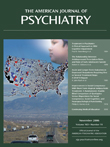Abstract
Objective: Studies of the familiality of obsessive-compulsive disorder (OCD) have yielded inconsistent results. This study compared the familial aggregation of OCD in first-degree relatives of community subjects with never-treated OCD, outpatients with OCD, and comparison subjects. Method: Fifteen persons from the community with untreated OCD were matched on age and interview type (direct or through family informants) with 90 OCD patients from four treatment facilities and 70 comparison subjects. Direct or indirect interviews using the German-language version of the Schedule for Affective Disorders and Schizophrenia—Lifetime Version for Anxiety Disorders (DSM-IV) were obtained from 58, 285, and 247 first-degree relatives, respectively, of the three groups. The rate of OCD in case versus comparison relatives was assessed with chi-square tests, and odds ratios were calculated for risk estimation. Cox proportional hazards analysis was used to estimate the age-related risk of relatives of being affected by OCD. Results: Cox proportional hazards analyses revealed a 6.2-fold higher risk (hazard ratio) for relatives of all OCD cases for definite OCD and a 2.2–fold higher risk for subclinical OCD compared with relatives of comparison subjects. For relatives of community subjects with OCD, the risk for definite OCD (10.3% versus 5.6%) was 1.6, and the risk for subclinical OCD (15.4% versus 4.1%) was 3.4 compared with relatives of OCD patients from treatment sites. Conclusions: These results from the first controlled European family study of OCD confirm earlier U.S. data on the familiality of OCD in patients recruited from treatment facilities. The finding of a comparable familial aggregation of definite OCD and a higher familial aggregation of subclinical OCD in relatives of never-treated persons with OCD from the community strongly supports the impact of familial-genetic factors in OCD.



